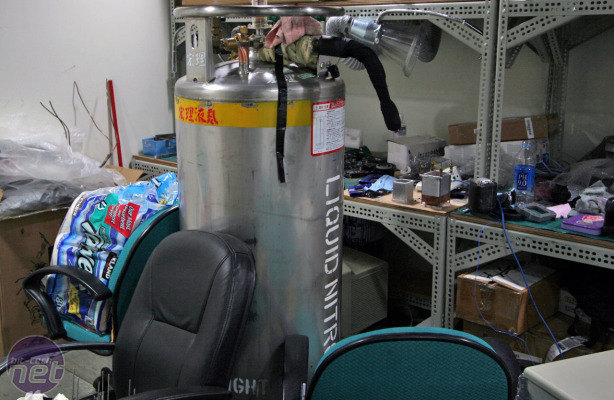
SR-2 BIOS, tweaking and future boards
BT: For voltage check points, they're just dots on the PCB, are you not worried people might slip and scour the board? Do people even use it that often or is it a feature for features' sake?Shamino: I don't know about everyone but I use it quite often. I think it depends on the type of user, it depends on their usage model - some guys just want to have the assurance - they don't trust the BIOS, the software or anything, just their multi-meters.
BT: How hard was it to work with a dual CPU setup for BIOS tweaking and overclocking versus normal single socket LGA1366?
Shamino: Base clock wise it was tougher to go higher. In the same environment you'll get 200MHz or so versus maybe 215MHz say on a normal X58 board.
The main thing is that clock frequencies are limited because of locked multipliers. There's no Extreme Edition Xeon CPUs so to get to 6Gs even on a 26x multiplier that some Xeon's have you need a 250MHz base clock, which is really, really tough. So, I think the main stumbling block for us is the unavailability of an unlocked Xeon, which we're talking to Intel about.
BT: But can you still overclock a single CPU Extreme Edition in the board though?
Shamino: No. You can't even run a single QPI [consumer Core-i7] CPU in it. The reason being that Intel twist the CPU in its socket for Xeon CPUs so it's in such a way that using a normal Core-i7 points the only available QPI to the other socket, and not the X58 chipset. Xeons with dual QPI point to both each other and the X58. Intel did it on purpose to make sure people bought their Xeon CPUs.
So unless some engineering company makes a link chip that diverts the QPI traffic to the X58, it won't happen, but I can't see why any company would bother.
BT: Are you planning any more dual-CPU motherboards?
Shamino: It's still just this one for now. I think that the guys want to see the response on the SR-2; it depends on how well this one is received in the market to determine our future commitment. Maybe a cut down version of it or a thinner one perhaps - maybe they don't want all the slots or to use it in their own case rather than on the desktop. You can't satisfy everyone on every product, and when you commit to a board you have to make it worthwhile doing.
BT: You briefly mentioned the boards size: the HPTX form factor - is that an actual form factor?
Shamino: No, that's just something our marketing department came up with, along with XL-ATX which is something we first did too and others copied.
BT: Do you know if Nvidia plans an update to the NF200 chip?
Shamino: I'm not sure, I suppose once PCI-Express 3.0 comes out [Nvidia] should if it wants to keep selling many-GPU solutions. Or it might just finish up entirely with NF200 and stop the chipsets altogether? For something that [Nvidia] committed such a small investment to, the ROI must be fantastic so I don't see why not make another.

MSI MPG Velox 100R Chassis Review
October 14 2021 | 15:04









Want to comment? Please log in.